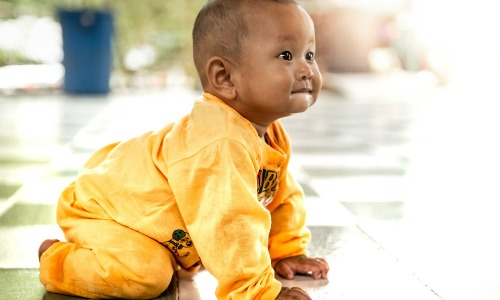The Crawling Milestone: A Guide to When Babies Begin Exploring Independently
Babies are constantly reaching new milestones, each one marking a significant step in their development. One such milestone that parents eagerly anticipate is crawling. It’s a moment that signals a newfound sense of independence and exploration for babies as they begin to navigate their surroundings on their own. In this article, we’ll explore the journey of when babies typically start crawling, the signs that indicate readiness, and how parents can support this exciting stage of development.
The Timing of Crawling:
Crawling usually begins between the ages of 6 and 10 months, although some babies may start a little earlier or later. The exact timing can vary widely from one child to another, influenced by factors such as muscle strength, coordination, and motivation.
Before babies start crawling, they often show signs of readiness through various physical and developmental cues. These may include:
- Improved muscle strength: Babies gradually build up the strength in their arms, shoulders, and core muscles through activities like tummy time, which helps prepare them for crawling.
- Coordination: Babies practice moving their arms and legs independently and may begin to rock back and forth on their hands and knees in preparation for crawling.
- Increased curiosity: Babies become more curious about their surroundings and may show a desire to explore beyond their immediate reach, motivating them to start moving.
The Crawling Process:
Once babies start crawling, they may initially use a variety of techniques to get around, including:
- Hands-and-knees crawling: This is the classic crawling style where babies move forward on their hands and knees, pushing off with their hands and propelling themselves forward with their legs.
- Army crawling: Some babies prefer to move forward by dragging themselves along the floor using their arms while keeping their belly close to the ground.
- Bottom shuffling: Others may scoot around on their bottoms, using a combination of pushing with their legs and propelling themselves forward with their arms.
As babies gain confidence and strength, their crawling skills typically improve, and they become more efficient at moving around independently. Crawling is not only a physical milestone but also an important cognitive one, as babies learn to navigate their environment, explore new objects, and develop spatial awareness.
Supporting Your Baby’s Crawling Journey:
As a parent, there are several ways you can support your baby’s crawling development:
- Provide plenty of tummy time: Tummy time helps strengthen your baby’s muscles and build the skills they need for crawling. Aim for short sessions several times a day, gradually increasing the duration as your baby grows stronger.
- Create a safe environment: Baby-proof your home to create a safe space where your baby can explore without getting into harm’s way. Remove any potential hazards and ensure that furniture is secured to prevent tipping.
- Encourage exploration: Place interesting toys and objects just out of your baby’s reach to encourage them to move and explore. You can also get down on the floor and crawl alongside your baby to provide encouragement and support.
Conclusion:
The journey of when babies start crawling is an exciting time for both babies and parents alike. It marks the beginning of a new chapter in your baby’s development as they gain independence and explore the world around them. By understanding the signs of readiness, supporting your baby’s efforts, and creating a safe and nurturing environment, you can help your little one master this important milestone with confidence and joy.


